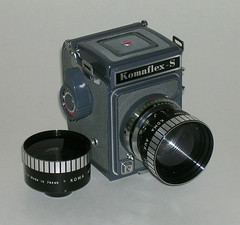Komaflex-S
The Komaflex-S is a Japanese 4×4 SLR made by Kowa from 1960, for export only.
Contents
Description
The Komaflex-S has a small body with a roughly cubic shape and a gray finish, covered by light gray leatherette. The film travels vertically and is advanced by a ratchet knob on the photographer's right. The knob contains a film reminder, and it is shaped as a hook towards the top, so that it can be pushed by the thumb. It lowers the mirror and advances the film in the same movement. It cannot be turned unless the release button has been tripped, to avoid blank exposures.
There is a round exposure counter window on the photographer's right, near the bottom. The position of the first exposure is set via a red window placed under the camera, protected by a rotating cover controlled by a small thumb-operated button. The exposure counter is engaged by a sliding lever placed below the advance knob, towards the rear. The same lever also unlocks the shutter cocking lever when the camera is not loaded with film, allowing to open the shutter and see through the finder.[1]
The left side of the camera only has an accessory shoe, engraved with the serial number. The L-shaped back is hinged at the top and locked by a latch controlled by a knob surrounding the tripod thread, with O and C indications.
The viewing hood is copied on that of the Rolleiflex Baby Grey; it has a square magnifying lens hinged to the front and a flap for a sportsfinder with a red Koma logo in the middle. The viewing screen has a Fresnel lens to enhance the luminosity.[2] The nameplate is rectangular and reads Komaflex–S on a black background. There are strap lugs on both sides of the body.

|
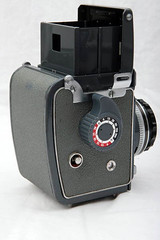
|
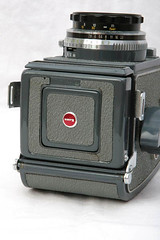
|

|
| Komaflex-S, early style, body no.2111xx, lens no.750350. Pictures courtesy of eBayer lensman. (Image rights) | |||
The shutter release is at the bottom of the front standard, and is actuated by the photographer's right fingers. The lens is a fixed Prominar 65mm f/2.8; it has four elements in three groups and its elements contain rare earth glass.[3] The shutter is a Seikosha-SLV (B, 1–500).
The lens barrel has a fixed gray ring on the rear, inscribed Made in Japan at the bottom, with cut-outs for the M/X/V selector, the PC synch socket, the shutter cocking lever, and the interlock for the Light-Value system. The shutter cocking lever opens the shutter blades, winds its main spring and opens the diaphragm to full aperture for viewing. The lever can be operated only after the advance knob is turned, to avoid double exposures. It is locked when the camera is not loaded with film, unless the sliding button engaging the exposure counter is pushed to the rear. To force the shutter cocking lever without unlocking it runs the risk of breaking the mechanism.
To the front of the fixed gray ring is the silver speed ring (B, 1–500), which also has a light-value scale from 3 to 18. Further to the front is the aperture scale, from 2.8 to 22 on a black background. The diaphragm is left fully open for viewing. When the release is pressed, the diaphragm is set to the selected aperture, the shutter blades are closed and the mirror is lifted, before the shutter is tripped.
The black focusing ring has one row of wide knurls. It only advances the lens frontmost element. The distance scale is engraved both in metres (in white) and feet (in yellow), down to 1 metre or 3 feet. There are depth-of-field indications immediately to the rear, and the shutter name SEIKOSHA–SLV is engraved on the same plate at the bottom. The lens bezel is black and takes screw-in 37.5mm diameter filters.[4] The lens cap is black and has the Koma name in relief.
Commercial life

|
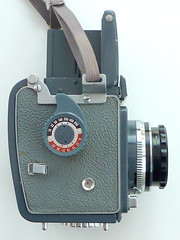
|
| Komaflex-S, later style, lens no.752534. Images by Tony Kemplen.(Image rights) |
The Komaflex-S was featured in Japanese camera magazines dated January to June 1960.[5] The camera was made for export only and no Japanese advertisement is reported. The advertisement in the September 1960 issue of Popular Photography[6] mentions Ideax Corp. as the exclusive U.S. agent, gives the price of $69.95 (case extra $10.00), and mentions the availability of telephoto and wide angle conversion lenses (see below). The advertisement also says that the camera is "the world's first and only super-slide single-lens reflex camera". The same assertion is repeated in the user manual.[7] This is inaccurate, and other 4×4 SLRs were made before the Komaflex, like the Super Flex Baby or the Atomflex; however they were not exported and the notion of 4×4 "super-slide" was not invented at the time they were made.
It seems that the name originally intended for the camera was "Kowaflex", the same as the Kowaflex 35mm SLR made by the same company; the rumour says that the company wanted to register the trademark "Kowaflex" in the US, and when the trademark registration was granted the name had become "Komaflex", because someone misread an "m" for a "w".[8]
The camera was also sold under the name Optomax S by the German distributor Foto-Quelle.[9] This name variant only differs by the nameplate, inscribed Optomax S.[10]
Build quality
The Komaflex has attracted some harsh criticism for its supposed lack of reliability.[11] The inability to cock the shutter when the exposure counter is not activated is counter-intuitive, and the interlock mechanism between the shutter cocking lever and the advance knob is certainly fragile: the instruction manual repeatedly insists on the importance of not forcing the shutter cocking lever.[12] It also advises not to force the advance knob if it stops when loading the film, but to press the shutter release to unlock it.[13]
In addition to the risk of improper use, it seems that some parts were not correctly dimensioned or were made of poor materials, because the camera was built on a budget.[14] Apart from the winding and cocking mechanism, some users advise not to press the sportsfinder flap too hard because the stopping part may break.[15]
Add to this the inherent complexity of the leaf-shuttered SLR design, which caused problems for all but the major camera makers, and the reliability concerns about the Komaflex-S are probably founded.
Evolution and total production
The cosmetics of the Komaflex-S changed slightly during its production run. The early style has a half-circle shutter-setting lever and a round sliding button on the side to engage the exposure counter mechanism. The later style has a more angular shutter-setting lever, and a more modern-looking rectangular exposure counter button.
The body numbers observed are all in the 21xxxx or 22xxxx range; the lowest is 2111xx and the highest is 221012. The transition from the early style to the later style occurred around the serial number 214xxx. There was not a fixed point in production at which the style was changed; some later style cameras have been observed with serial numbers below 214xxx[16], while some early style cameras have been observed with serial numbers above 214xxx[17]. The known lens numbers are in the 75xxxx and 76xxxx ranges; the lowest is 750307 and the highest is 761399. The lens number sequence is not coherent with the body sequence, with early lenses mounted on late bodies and the reverse. It seems that a single batch of numbers was specifically affected to the lens of the Komaflex-S, instead of numbers interspersed in a common sequence for all Kowa lenses. From the numbers observed so far, total production of the Komaflex-S can be estimated at little more than 11,000 units.
Accessories
 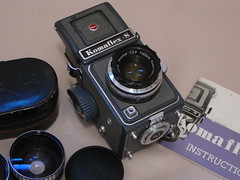
|
| Komaflex-S, early style, body no.213378, lens no.752604, full set with auxiliary lenses. (Image rights) |
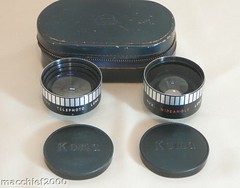
|
| Komaflex-S auxiliary lenses, silver-striped barrel. (Image rights) |
Telephoto and wide angle conversion lenses were offered for the camera; the telephoto offers 1.5× magnification, roughly corresponding to a 100mm lens, and the wide angle gives a 1.4× wider field, roughly corresponding to a 45mm lens.[18] Both keep the full f/2.8 aperture and take 52mm diameter filters.[19] At least two versions exist. One version has a cylindrical black barrel with silver stripes at the front; it is engraved KOMA AUX. WIDEANGLE LENS F:2.8 (with WIDEANGLE in red) or KOMA AUX. TELEPHOTO LENS F:2.8 (with TELEPHOTO in white) and has a five-digit serial number.[20] The other version has an all black barrel with a rather conical shape; it is engraved KOMA AUX. WIDE ANGLE LENS or KOMA AUX. TELE LENS (with WIDE ANGLE in red and TELE in yellow), and perhaps has a serial number as well.[21] It seems that the two conversion lenses were sold together as a set with a common leather case and two Koma lens caps.
The leather case for the camera has a peculiar shape; it is known with a Koma logo embossed or attached at the front. The original box is gray with a black bar, the name Komaflex, a large red S and the mention MADE IN JAPAN.
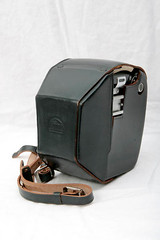 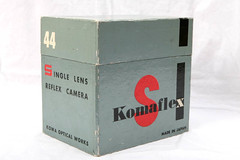
|
| Komaflex-S leather case and original box. Pictures courtesy of eBayer lensman. (Image rights) |
Notes
- ↑ Instruction manual at butkus.org.
- ↑ Fresnel lens: instruction manual at butkus.org.
- ↑ Four elements in three groups: Hagiya, p.33, Kokusan kamera no rekishi, p.388. Rare earth glass: instruction manual at butkus.org.
- ↑ 37.5mm diameter: see this page at onetwoseven.org.uk.
- ↑ Kokusan kamera no rekishi, p.388.
- ↑ Advertisement reproduced in Hagiya, p.33.
- ↑ Instruction manual at butkus.org.
- ↑ See this page of gatapasya's blog (archived). A slightly different version of the rumour appears in Iguchi, p.38.
- ↑ McKeown, p.303.
- ↑ Example pictured in McKeown, p.303.
- ↑ See for example Matanle, pp.230 and 239.
- ↑ Instruction manual at Butkus.org: the advice is repeated on pp.3, 12, 31, 32.
- ↑ Instruction manual at Butkus.org, p.10.
- ↑ Iguchi, pp.38–40, and this page of gatapasya's blog (archived).
- ↑ Iguchi, p.38.
- ↑ No.213388 pictured in Hagiya, p.33, and in Iguchi, pp.38–40. No.213695 observed in an online auction.
- ↑ No.214579 observed in an online auction, and No.2148xx owned by Camera-Wiki user Tarn McDaddo.
- ↑ Instruction manual at butkus.org.
- ↑ Filter diameter: see this page at onetwoseven.org.uk.
- ↑ Examples pictured in Matanle, p.230, pictured in this page at onetwoseven.org.uk and observed in an online auction.
- ↑ Example observed in an online auction.
Bibliography
- Asahi Camera (アサヒカメラ) editorial staff. Shōwa 10–40nen kōkoku ni miru kokusan kamera no rekishi (昭和10–40年広告にみる国産カメラの歴史, Japanese camera history as seen in advertisements, 1935–1965). Tokyo: Asahi Shinbunsha, 1994. ISBN 4-02-330312-7. Item 1300.
- Hagiya Takeshi (萩谷剛). "Kōwa no yushutsu-yō kamera" (コーワの輸出用カメラ, Kowa cameras for export). Kamera Rebyū: Kurashikku Kamera Senka (カメラレビュー クラシックカメラ専科) / Camera Review: All about Historical Cameras no.40, December 1996. Kōwa no subete (特集:R型ライカのすべて, All of Kowa) and Roshia kamera korekushon (ロシアカメラコレクション, Russian camera collection). Pp.30–3.
- Iguchi Yoshio (井口芳夫). "4×4-han ichigan-refu no Komafurekkusu-S" (4×4判一眼レフのコマフレックス-S, Komaflex-S 4×4 SLR). Kamera Rebyū: Kurashikku Kamera Senka (カメラレビュー クラシックカメラ専科) / Camera Review: All about Historical Cameras no.40, December 1996. Kōwa no subete (特集:R型ライカのすべて, All of Kowa) and Roshia kamera korekushon (ロシアカメラコレクション, Russian camera collection). Pp.38–40.
- Matanle, Ivor. Collecting and Using Classic SLRs. London: Thames & Hudson, 1996. ISBN 0-500-01726-3. Pp.230 and 239.
- McKeown, James M. and Joan C. McKeown's Price Guide to Antique and Classic Cameras, 12th Edition, 2005-2006. USA, Centennial Photo Service, 2004. ISBN 0-931838-40-1 (hardcover). ISBN 0-931838-41-X (softcover). Pp.303 and 547.
- Sugiyama, Kōichi (杉山浩一); Naoi, Hiroaki (直井浩明); Bullock, John R. The Collector's Guide to Japanese Cameras. 国産カメラ図鑑 (Kokusan kamera zukan). Tokyo: Asahi Sonorama, 1985. ISBN 4-257-03187-5. Item 2135.
Links
In English:
- Komaflex-S among other medium format SLRs at Rick Oleson's website
- Komaflex-S at onetwoseven.org.uk
- Komaflex-S at Photography for Profit or Fun
- Komaflex-S at Cameras Downunder
- Instruction manual in English at butkus.org's
In Japanese:
- Komaflex-S at Hiura Shinsaku's camera site
- Komaflex-S at gatapasya's camera blog (archived), with a picture of the insides of the advance mechanism
- Komaflex-S in a page of the AJCC website
- Komaflex-S and VP Exakta at Asacame
- Komaflex-S: repair notes and sample pictures at Kan's Room
- Komaflex-S at Kosaka's website
- Komaflex-S in the Kowa camera page (archived)
- Kowa camera specs in Shihira's Kowa page (archived)
